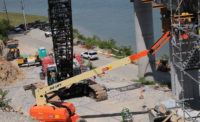2017 Construction Outlook
Viewpoint: AIA Forecasts Healthy Advances for US Nonresidential Market Through 2017

Commercial construction sectors are projected to be the strongest performers in 2016, with the institutional categories in retreat from last year’s pace.
Image courtesy of Pixabay
By Kermit Baker
The national economy seems to be on a slower growth path so far in 2016, in part due to a growing list of national and international vulnerabilities. The slower growth in the broader economy is beginning to put downward pressure on the construction industry.
After a solid performance last year, where most commercial and industrial construction sectors grew by 20% or more, activity was expected to moderate in 2016.
The year has gotten off to a solid start, but the American Institute of Architects’ Consensus Construction Forecast Panel anticipates that growth will moderate as the year progresses. Overall, building construction spending is expected to grow around 6% this year and stay in that range for 2017.
Commercial construction sectors are projected to be the strongest performers in 2016, with the institutional categories in retreat from last year’s pace. Next year, the commercial sectors are expected to see slower yet still healthy growth, while most institutional markets will accelerate.
Economic Roadblocks
There are many positive signs in the economy at present. Job growth continues to be healthy, the national unemployment rate is below 5%, consumer confidence levels are strong, the rate of inflation is extremely low, energy costs remain well below their average of the past several decades, interest rates are near record-low levels, stock prices remain high in spite of unusual volatility and the single-family housing market is poised for very strong growth.
Still, a growing list of issues threatens to unhinge the economic expansion, both national and international, as follows.
- The U.S. manufacturing sector remains weak. The output of the nation’s factories has declined in 13 of the past 17 months, dating back to the beginning of 2015. As a result, business investment has dropped sharply since the third quarter of last year. Business confidence levels are suffering, with the Conference Board’s CEO’s Business Confidence Index lingering in negative territory since the middle of last year.
- International economies are starting to drag U.S. markets down. The sense of gloom in the manufacturing sector is reinforced by several emerging international economic trends that are likely to diminish U.S. exports. Key international economies—including China, Brazil, and Russia—continue to face difficulties. The recent decision by the UK to exit the European Union won’t have a direct effect on U.S. exports, but it may set off a new round of restrictive trade policies. Regardless, the strong dollar, which has strengthened as international economies have faltered, provides incentives for increasing imports, which further undermines the nation’s manufacturing sector.
- The upcoming presidential election is increasing uncertainty. Presidential elections tend to depress economic growth in the six months leading up to them because many investors are reluctant to move ahead with projects, given that policies may change. This time, the level of uncertainty about post-election policies is unusually high, which likely will depress investment even more.
This rising unrest can already be seen in Federal Reserve actions. The Fed has postponed short-term interest rate hikes so far in 2016. While low interest rates have many positive benefits, they underscore the weak demand throughout the U.S. economy. They also have inflated the value of real assets like stocks and real estate, which leaves the economy more vulnerable to a downturn, should a negative event materialize.
Construction Outlook
In spite of a growing list of threats to the U.S. economy, and therefore the construction sector, the outlook remains reasonably favorable overall. For example, AIA’s Architecture Billings Index (ABI)—an indicator of construction activity that leads spending in the nonresidential sector by nine to 12 months—continues to send off positive signals.
It has remained in the growth range since mid-2012, and in spite of recent volatility, the ABI still documents increases in design activity at U.S. architecture firms. There are signs that progress in design activity may be slowing: the average ABI score of 51.8 for the first half of 2015 dipped to 51.3 for the second half of last year and continued to ease to closer to 51 for the first half of this year.
Still, the new design contracts index introduced by AIA, which measures new project activity coming into architecture firms, remains above the billings index. This suggests that architecture firms are increasing their backlog of projects.
Some evidence indicates that gains in construction activity will continue to slow in the coming quarters. A consensus forecast of real-estate trends conducted by the Urban Land Institute suggests that the country is in the latter stages of the current real-estate cycle. ULI’s forecast sees vacancy rates rising and rent increases slowing for the multifamily and hotel markets through 2017 and 2018. The office and retail sectors are projected to see more stable vacancies with slower rent gains, so they, too, seem to be in the latter stages of the current cycle.
Commercial property values also could affect future growth in the sector. Nationally, they are about 10% above their prerecession highs, according to data from CoreLogic. International economic concerns—particularly with emerging weakness in Europe following the UK vote—may drive more capital to U.S. real estate markets, coaxing prices even higher in the coming months.
The AIA Consensus Construction Forecast Panel sees healthy but slower growth in nonresidential building. After an estimated 17% growth in 2015, the consensus is for 5.8% growth in overall building construction activity this year, declining modestly to 5.6% in 2017.
The commercial sectors are expected to be the strongest performers, with an 11.7% gain this year and 6.5% next year, paced by continued strong performance in office and retail. Industrial construction, which saw growth last year in excess of 40%, is projected for essentially flat levels of construction this year and next.
Healthy single-digit growth is expected from the institutional sector in 2016 and 2017. An optimistic outlook remains for education facilities, with gains in excess of 6% projected for both this year and next. The outlook for the health care sector has dimmed a bit, with growth forecasts falling to just over 2% this year before ramping up to 5% in 2017.
Kermit Baker is the chief economist for the American Institute of Architects and part of the AIA Economics and Market Research Group, which provides AIA members with insights and analysis of the economic factors that shape the business of architecture.





